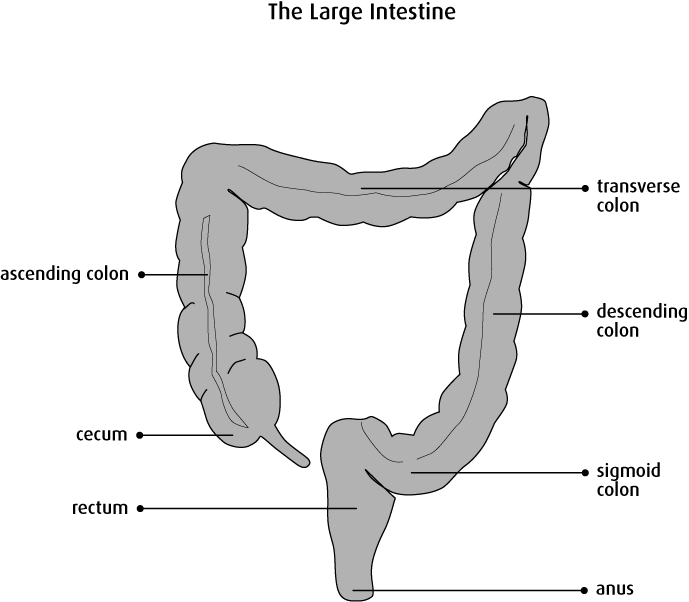Colon and rectum
The intestine is part of the digestive system. It is made up of the small intestine and the large intestine. The colon and rectum are parts of the large intestine. The colon is a U-shaped tube made of muscle and found below the stomach. The rectum is a shorter tube connected to the colon. Together, the colon and rectum are about 2 metres (6 feet) long. They are surrounded by other organs including the spleen, liver, pancreas, bladder and reproductive organs.
Parts of the large intestine
The large intestine is made up of the cecum, colon, rectum and anus. The colon and rectum are held in the abdomen by folds of tissue called mesenteries.
• Cecum
The cecum is a pouch-like passage that connects the colon to the ileum (the last part of the small intestine). If cancer develops in the cecum, it is treated like colon cancer.
• Colon
The colon is the longest part of the large intestine. It receives almost completely digested food from the cecum, absorbs water and nutrients, and passes waste (stool or feces) to the rectum. The colon is divided into 4 parts.
The ascending colon is the start of the colon. It is on the right side of the abdomen. It continues upward to a bend in the colon called the hepatic flexure.
The transverse colon follows the ascending colon and hepatic flexure. It lies across the upper part of the abdomen. It ends with a bend in the colon called the splenic flexure.
The descending colon follows the transverse colon and splenic flexure. It is on the left side of the abdomen.
The sigmoid colon is the last part of the colon that connects to the rectum.
• Rectum
The rectum is the lower part of the large intestine that connects to the sigmoid colon. It is about 15 cm (6 in) long. It receives waste (stool or feces) from the colon and stores it until it passes out of the body through the anus.
• Anus
The anus is the opening at the lower end of the rectum through which waste (stool or feces) is passed from the body. Cancer in the anal canal or anus is treated differently from colorectal cancer. Find out more about anal cancer.
Layers of the Colon and Rectum
The colon and rectum are made up of different layers of tissues.
• Mucosa
The mucosa is the inner lining of the colon and rectum. It is made up of:
• a thin layer of epithelial cells (called the epithelium)
• a layer of connective tissue (called the lamina propria)
• a thin layer of muscle (called the muscularis mucosa)
• Submucosa
The submucosa is a layer of connective tissue that surrounds the mucosa. It contains mucous glands, blood vessels, lymph vessels and nerves.
• Muscularis propria
The muscularis propria lies outside the submucosa. It is a thick layer of muscle. It has an inner ring of circular muscle fibres and an outer ring of long muscle fibres that surround the wall of the colon and rectum.
• Serosa
The serosa is the outer layer of the colon. It is not found on most of the rectum.
Function
The colon and rectum:
• absorb water and some nutrients from what we eat and drink
• form and store waste (stool or feces)
• move waste out of the body
Partly broken down or digested food moves from the small intestine into the colon. Sections of the colon tighten and relax to move the food through the colon and rectum. This movement is called peristalsis.
In the colon, bacteria break down food into smaller pieces. The inner layer of the mucosa (called the epithelium) absorbs, or takes up, water and some nutrients. The liquid waste remaining in the colon is formed into semi-solid stool (also called feces).
The mucosa also makes mucus that helps stool move easily through the colon and rectum. As stool moves through the colon, more water is absorbed from it and it becomes more solid.
Stool leaves the colon and moves into the rectum. The rectum is a holding area for the stool. When the rectum is full, it pushes the stool out of the body through the anus.



